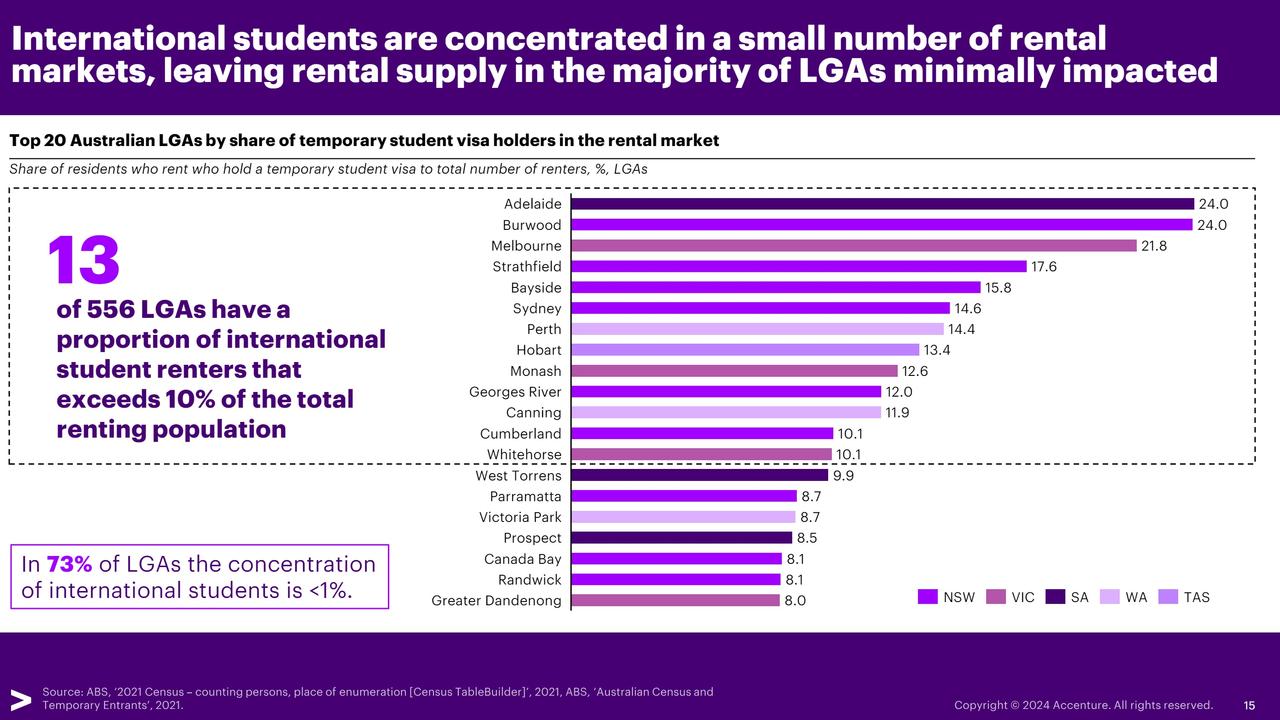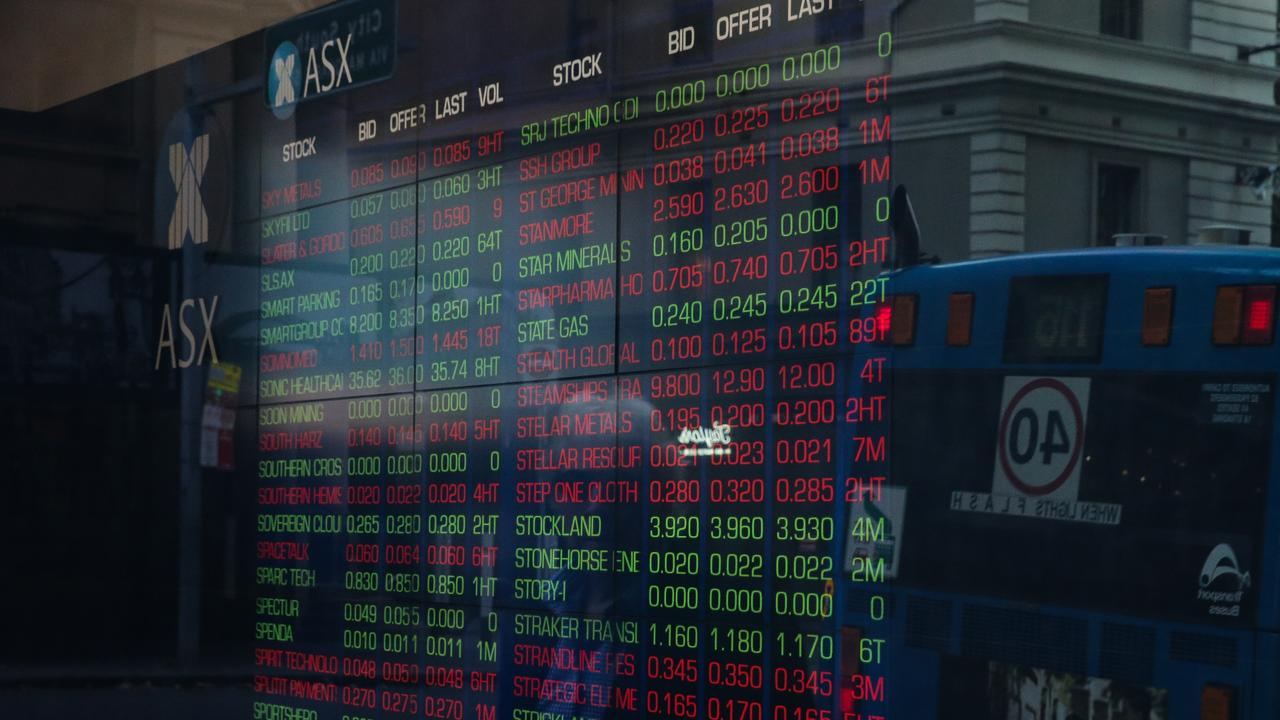‘It really is a scam’: University of Sydney professor hits out at international student ‘rort’
A University of Sydney professor has taken aim at a $40 billion “scam” he says is making life miserable in Australia’s capital cities.

EXCLUSIVE
A landmark report by the property industry which argued international students are “not to blame” for the housing crisis has been slammed by an expert highlighting how “simple math” in the study’s own figures appear to contradict one of its key claims.
The report released late last month by the Student Accommodation Council — part of the national Property Council lobby group — said international students had “unfairly worn the blame for Australia’s rental crisis” but they were “not the cause” either of rising rents or low vacancies, making up just 4 per cent of renters nationwide.
“In fact, a far bigger impact on rental housing availability has been the post-Covid trend to work from home,” Student Accommodation Council executive director Torie Brown wrote in an opinion piece for the Herald Sun.
“We need to grow the amount of student accommodation to provide greater housing options for students without forcing them to compete for private rentals. It’s time to stop pointing the finger at international students, and instead point it at ourselves.”
But University of Sydney Associate Professor Salvatore Babones, a vocal critic of the sector who has labelled the international student market a “scam”, said the report had unintentionally made an “incredible” admission.
“Their own statistics damn them,” Prof Babones told news.com.au.

“If you go to page 15, it says 13 [out of 556] local government areas have international students that exceed 10 per cent of the rental market and in 73 per cent of LGAs the concentration is under 1 per cent. [That means] in 27 per cent of LGAs — which are virtually all in capital cities, not rural areas — the concentration is over 1 per cent.
“Well, what is the rental vacancy rate? It’s 1 per cent.
“Which means if there were no international students, in 27 per cent of LGAs the rental availability, by a very rough cut according to their analysis, would double. And that’s only for LGAs where the concentration is 1 per cent. For those that are above 10 per cent or up at 24 per cent, that’s incredibly warping to the rental market.”
The Student Accommodation Council report identified Adelaide and Burwood as the LGAs with the highest concentration of international student renters at 24 per cent each, followed by Melbourne on 21.8 per cent, Strathfield on 17.6 per cent, Bayside on 15.8 per cent and Sydney on 14.6 per cent.
Perth, Hobart, Monash, Georges River, Canning, Cumberland and Whitehorse were all above 10 per cent.
“They didn’t do the simple math,” Prof Babones said.
“In their minds they were showing that international students had no impact on the rental market. They didn’t realise their own data they’re promoting actually contradicts their claims.”
Ms Brown said in response that “the LGAs with high international student rates are the LGAs with large amounts of student accommodation”.
“Students living in student accommodation are captured in broader rental figures,” she said.
“For example, the City of Adelaide has 24 per cent international students in the rental market, but it also has around 7000 student accommodation beds. If you removed international students from the Adelaide CBD population, you wouldn’t add a huge amount of general rental stock back into the market, but you would have a large amount of empty student accommodation buildings.”

‘Who benefits from this?’
Prof Babones is the author of the 2021 book Australia’s Universities: Can They Reform?, which attempted to push back on claims about the international student boom made by the university lobby.
“I wrote a book about it because no one else was discussing these things,” he said.
Two years earlier, in a paper for the Centre for Independent Studies (CIS) think tank, Prof Babones accused Australian universities of “taking a multi-billion dollar gamble with taxpayer money to pursue a high-risk, high-reward international growth strategy that may ultimately prove incompatible with their public service mission”.
Despite working at a university — where he teaches international students — he doesn’t mince words.
“The scam — and I call it a scam, or a rort — is that universities are allowed in effect to sell work visas in exchange for free cashflow that they can direct to their own research priorities,” he said.
In his book, Prof Babones draws the connection between international student revenue and university rankings to show “essentially the money is being recycled into purchasing high-citation researchers, who generally don’t teach, to move to Australia” and fund their research without having to apply for grants.
“So you use international student money in accounting 101 to pay for a top-notch chemistry researcher,” he said.
“Who benefits? Well the vice-chancellor benefits because the university is now ranked 50 instead of 80 and they get a bonus on that basis. The researcher benefits, but those aren’t Australian researchers. International students benefit because they get access to the Australian work market.
“Australians don’t benefit, the government doesn’t benefit, Australian students don’t benefit. Everyone pays higher rent in the city. It really is a scam.”
Prof Babones, a quantitative comparative sociologist and widely cited commentator on higher education, went on to outline a number of striking facts about the international student market he said might come as surprise to most Australians.

Postgrad spouses work full time
The American academic is one of the few commentators to cast doubt on the commonly cited claim that international education is one of Australia’s largest “exports”, up there with coal and iron ore, bringing in around $40 billion a year.
The figure, produced by the Australian Bureau of Statistics (ABS), has also been called into question by economists Cameron Murray, author of The Great Housing Hijack, and MacroBusiness co-founder Leith van Onselen.
They argue it does not take into account income earned by students while working in Australia — around 52 per cent of international students work — or money sent back to their home countries.
“I would go further and say the tuition is not export revenue,” Prof Babones said.
“International student tuition is overwhelmingly not paid from abroad. At the postgraduate level I suspect most international student tuition is being paid out of earnings in Australia, either directly or indirectly by repaying unreported loans. That is, someone borrowed money five years ago, put it in a bank account to show they can pay the tuition, pay the tuition out of the bank account, but their work earnings are paying that loan off.”
The practice was “absolutely routine” in India and Nepal for students to “game the financial requirements” by getting loans from family or even loan sharks years in advance to secure a visa, according to Prof Babones.
“Those funds are never coming to Australia,” he said.
He noted that while international student debates largely focused on undergraduates, around one third of multi-year visas to complete degrees were postgraduate.
“Unlike undergraduates, postgraduates can bring a spouse on their visa, and the spouse can work full time while they work part time,” he said.
“Obviously most of the money that couple is spending in Australia is being earned in Australia. These are not export earnings.”

Nepal is third-biggest student source
Prof Babones said one fact made it “absolutely clear” that the international student visa was an “indirect work visa for spouses”.
“The third-largest source of international students for Australia is Nepal,” he said.
“Nepal is a very poor country, around $US1300 per capita GDP, it is not a large country by the standards of China and India [which make up the top two], yet it is the source of something like 15 per cent of our international students. For a small, poor country half as rich as Indonesia to be our third-largest source of students is crazy.
“The reason is very obvious. It’s that they’re coming here to work, not study, and concentrated at the postgraduate level where you can get a work visa for your spouse.
“In Nepal it’s now an industry to send students to Australia to work, there are networks existing here in Australia that assist with this whole process.”
And the students themselves do not hide this fact.
Repeated surveys by education services firm Navitas have found that “quality of education” is far down the list of priorities for most international students.
Students from South Asia, Sub-Saharan Africa and the Middle East and North Africa (MENA) all ranked “access to post study work rights” as their top priority in the most recent survey, which polled 943 education agents in 72 countries in May 2023.
While previous commentary has focused on poor-quality or outright fraudulent qualifications offered by low-cost private colleges, it’s not clear exactly what postgraduate university degrees are represented in what Prof Babones characterises as the “thinly disguised” work visas.
“The government does not release it,” he said.
“They won’t give you the cut. You can get a cut by country, and by subject, and by university, but you can’t cross any of those. The answer I was given on freedom-of-information was commercial in confidence. It is ridiculous that public universities consider this commercially sensitive data.
“If you want to propose a postgraduate degree program at a school, you have to prepare essentially a marketing plan for international students, and unless you can show there’s a demand for it it’s unlikely to be approved.”

One in ten students comes to Australia
Australia’s population grew by a record 660,000, or 2.5 per cent, in the year to September to reach 26.8 million, Australian Bureau of Statistics (ABS) figures released in March show.
That was driven by record net overseas migration of 548,800 — compared with natural increase of 111,000 — largely from international students.
Prof Babones said Australia was “extraordinarily off the scale” in terms of international student numbers per capita.
“We take 8 per cent of the world’s international students,” he said.
“And that was in 2018 so it’s probably closer to 10 per cent today — 10 per cent of all the world’s international students are coming to Australia. Per 1000 population Australia has triple the number of our closest competitors UK and Canada. Australia is virtually tied with the UK for the number of international students and the UK has two-and-a-half times the population.
“Similarly, as a ratio of inbound to outbound Australia has three times any other country. Our ratio of inbound to outbound was 33 a few years ago, that’s probably around 35-40 today. Thirty-five times as many come to Australia as Australia sends overseas.”
As of March, there were more than 870,000 people on a student visa in Australia, according to Department of Home Affairs data.
That is around one in every 30 people in the country.
Prof Babones stressed that he had nothing against the students themselves.
“I’m an immigrant myself, I teach international students, I’m very sympathetic to international students,” he said.
“[But] none of this ultimately benefits Australian students, or very little of it.”
Universities Australia has been contacted for comment.
A spokesman for the peak body previously said “international education is great for Australia”.
More Coverage
“It underpins a higher standard of living for all Australians and supports essential jobs across the economy as well as the vital teaching and research activities our universities undertake,” he said.
“International students will play a crucial role economically and socially as we continue to recover from the pandemic.”
Read related topics:Sydney






